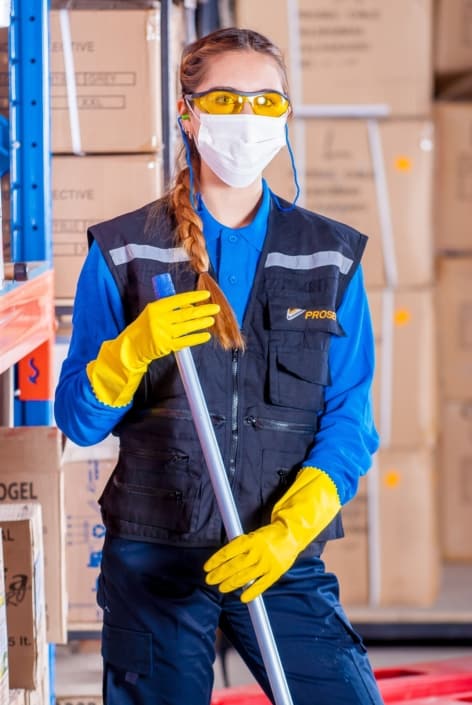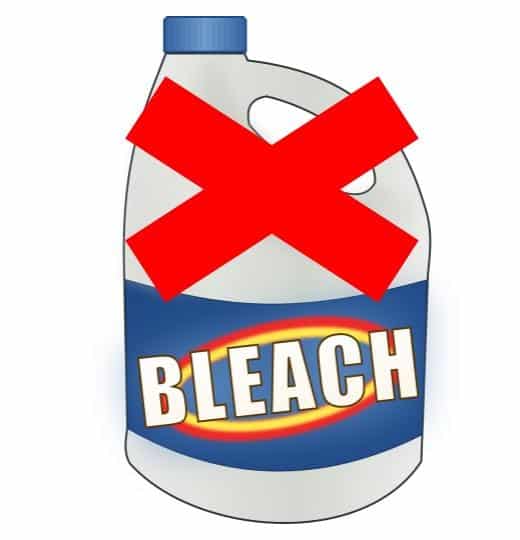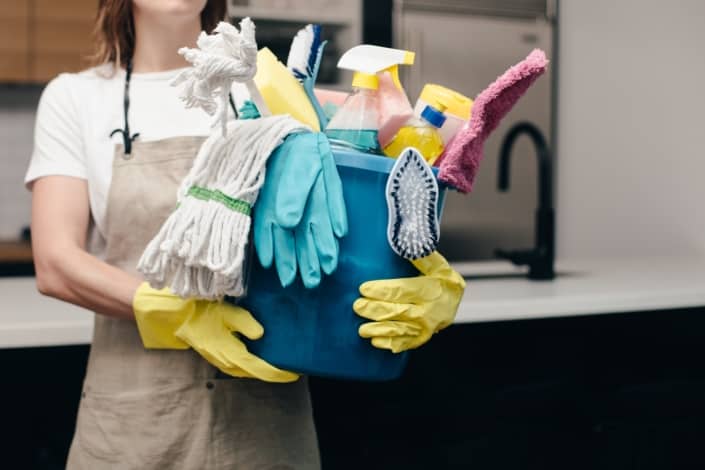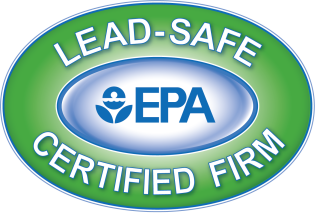Everyone has to clean mold from their home from time to time. Whether you live in a mansion or an apartment, your home is your safe place. The place you feel most comfortable.
Many of the cleaning products sold today are full of toxic chemicals and undisclosed ingredients. Keeping your home clean is essential, but how do you do that safely? How can you protect your pets, children, guests, and yourself from harmful chemicals?
Our simple guide will equip you to clean mold from the hard surfaces in your home with non-toxic ingredients you already have in the pantry! Come learn how to clean mold safely!
WHAT TO WEAR TO CLEAN MOLD SAFELY

Before even choosing a cleaning product, you should know what kind of safety equipment to wear to clean a moldy surface.
The basic equipment consists of an N-95 respirator, goggles or eye protection, & protective gloves with long cuffs. Long pants, a long sleeved shirt and waterproof boots are important to wear as well. Closed toed shoes are a good substitute for boots, especially if you are working on a small area of mold.
Mold is a respiratory irritant and allergen, so a mask with a N-95 respirator is important, especially if you know you are allergic to mold. A simple dust mask will NOT protect you from the mold spores. For more information about safety, visit: What to Wear before entering a Home or Building with Mold Damage by the CDC. To learn more about face masks see our post: In-depth Guide to Face Masks: Allergies, Grass Cutting, and COVID-19.
WHAT NOT TO USE TO CLEAN MOLD
The first thing people often turn to to clean mold is the worst choice. Bleach.

Bleach is a combination of chemicals used as an agent to kill bacteria and whiten clothes, floors, and walls. Bleach contains sodium hypochlorite which is toxic to bacteria, fish, and human beings. Sodium hypochlorite can cause respiratory, skin, and eye irritation or damage. This alone is enough reason to find a better alternative cleaning agent!
Of course, there are more reasons to avoid bleach. Bleach is designed to kill bacteria, and will not completely remove a mold problem. Molds are fungi, and they can and will grow back after bleaching.
Cleaning Product Safety
There are 3 simple ingredients you can safely use to clean away mold in your home: white vinegar, baking soda, hydrogen peroxide. Each of these ingredients has the highest safety rating on the Environmental Working Group’s Guide to Healthy Cleaning (EWG). Household cleaners are not food, drugs, or firearms, so the FDA (US Food and Drug Administration) does not regulate them. The EPA (Environmental Protection Agency) only requires manufacturers of cleaning products to list ingredients that are active disinfectants or could cause potential harm.
Manufacturers of commercial cleaning products for homes and businesses are NOT required to list all of their ingredients for consumers by any agency of the United States. They can claim that ingredients are a trade secret, and not disclose them on the product labels. The truth is that they can legally use just about anything in a cleaning product leaving you the consumer in the dark about its true safety and effectiveness.
To learn more about household and commercial cleaners, see our posts: Cleaning Products – Homemade vs. Store Bought and Branch’s Non-Toxic Spring Cleaning Guide.
Why You Shouldn’t Mix Cleaning Products
Cleaning products generally fall into one of two categories – acids and bases. Acids, like white vinegar, and bases, like baking soda, should normally not be combined. Why? When acids and bases are combined they chemically react. This reaction creates heat and changes the chemistry of both acid and base to a neutral solution. In the case of baking soda and vinegar, it also creates carbon dioxide gas. Much stronger acids and bases can create much more heat and more toxic gases! Be sure to run a ventilation fan or have a fan in a window when using these products.
WHAT TO USE TO CLEAN MOLD SAFELY
There are 3 simple ingredients you can safely use to clean away mold in your home: white vinegar, baking soda, hydrogen peroxide.

Hard Surface Cleaning
To clean a hard surface (like a shower stall, tiles, toilet, sink, or floor), simply add hydrogen peroxide OR white vinegar to a clean, empty spray bottle undiluted. Never mix these chemicals! Choose one or the other.
When using hydrogen peroxide, spray the area to clean thoroughly, and let it sit for 10-15 minutes. Then, scrub the area, and rinse it clean with water. Repeat if needed.
For white vinegar, spray the area to clean thoroughly, and let it sit for at least 15 minutes or up to one hour. Then, scrub the area, and rinse it clean with water.
To use baking soda, add a teaspoon to a tablespoon of baking soda to a clean empty spray bottle and fill the bottle ¾ full of hot water. Shake to dissolve. Spray the area and use a scrub brush to clean the mold away.
When using the Baking soda, it usually works best with a white vinegar spray following the baking soda. Baking soda is a base and vinegar is an acid. When they are used together, they react to form carbon dioxide gas and heat. The heat helps clean the surface and the chemical reaction kills fungi and bacteria alike.
TIPS FOR CLEANING MOLD
- Remember that your goal is not to kill the mold spores but to remove them. When they have been removed completely they cannot grow back.
- Be sure to spray and then wipe all surfaces with a damp rag. Dry wiping will disturb spores and send them into the air! Airborne spores can regrow in new locations, and cause even more mold to grow. Mold spores are not visible to the naked eye, so be sure to cover all surfaces with your cleaner of choice, even if they look ‘clean’.
- 5 to 10 drops of tea tree essential oil can be added to the white vinegar spray to increase the disinfectant power. Tea tree essential oil is distilled from the Melaleuca alternifolia tree from Australia. The essential oil is antifungal (kills fungi), antiviral (kills viruses), and antimicrobial (kills microbes, including bacteria). We advise people with allergies or asthma to use this oil with caution, as it can be irritating to the skin and lungs.
- Do NOT use a vacuum to clean mold unless you have a vacuum with a HEPA filter. HEPA stands for high-efficiency particulate air, which means the filter can stop most particles of dust, pet dander, allergens, etc. that are 0.3 microns or larger and keep them from being put back into the air. The HEPA filter should be changed periodically to increase efficiency. Mycotoxins may not be filtered out even when using a HEPA vacuum. Remember that you will eventually have to empty the vacuum, and it will be filled with the mold. So, vacuuming may not be the best method of removal. For a HEPA vacuum cleaner click here.
- Ventilate, ventilate, ventilate! Ventilation is important during cleaning so that any disturbed spores exit the building. Close and tape off doors to the rest of the house and use a box fan in a window pointing out while cleaning.
KNOW WHEN TO CALL THE PROS
It’s easy to take care of mold as a homeowner, but it’s also a good idea to know when to call in the pros. Mold is great at hiding in hard to detect locations such as in dry wall, under sinks, and in carpet. If the area of mold covers more than about 10 square feet, there is a good chance the mold problem is more than an isolated issue.
Call Branch Environmental. We’re experts at mold removal and indoor air quality. We can determine and remediate the underlying causes of poor indoor air quality from hidden mold sources to major contaminants. We can identify exactly what is going on in your home and rid it of environmental toxins, often for good.

